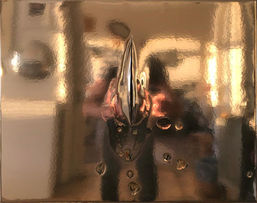About Artist
Ismet Dogan is seen as an established contemporary artist. Ismet Dogan was born in 1957. Artists born in the same year and of the same generation are Jorge Botero Lujan, Thomas Werner, Stefan Mås Persson, Franco Matticchio, and Vitor Ribeiro.
Further Biographical Context for Ismet Dogan;
Ismet Dogan was born in 1957 and was primarily inspired by the 1970s. The 1970s were a period of consolidation and development in the arts, most often defined as a response to the dominant strains of the preceding decade. Conceptual art developed as a key movement, and was in part an evolution of and response to minimalism. Land Art took the works of art into the spacious outdoors, taking creative production away from commodities and looking to engage with the earliest ideas of environmentalism. Process art combined elements of conceptualism with other formal reflections, creating mysterious and experimental bodies of work. Expressive figurative painting began to regain importance for the first time since the decline of Abstract Expressionism twenty years prior, especially in Germany where Gerhard Richter, Anselm Kiefer, Georg Baselitz became highly powerful figures worldwide. New York maintained an important position in the international art world, ensuring that international artists continued to flock to the galleries, bars and downtown scene in the city. The predominantly Italian Arte Povera Movement gained global recognition during the 1970s, with artists like Jannis Kounnelis, Mario Merz, and Michelangelo Pistoletto attaining worldwide recognition.
About Art Work:
Here the bodies, which sometimes appear half naked but devoid of all aesthetic value, are not partners of an erotic activity, an object of desire for one other. They rather seem to be the target of a mutual rage and aggression, of revenge, even of abasement. And the necessarily bring to mind the question of the origin of this rage. Are what we are facing carnivores who wish to annihilate the being of each other in one way or another?
Melancholy cannibalism… accounts fort his passion for holding within the mouth (but vagina and anus also land them self to this control)the intolerable other that I crave to destroy so as to better possess it alive. Better fragmented, torn, cut up, swallowed, digested… then lost. The melancholy cannibalistic imagination is a repudiation of the loss’ reality and of death as well. It manifests the anguish of losing the other through the survival of the self, surely a deserted self but not separated from what still and ever nourishes it and becomes transformed into the self-which also resuscitates – through such a devouring. (Julia Kristeva)
As Julia Kristeva remind us, melancholy, just like mourning, conceals an aggression towards the lost object. This is an ambivalence concerning the object of mourning. The rage and aggressiveness felt fort he other is in the truth the expression of the aggressiveness one feels towards oneself, for as Freud states there is a relationship of identity established in the un conscious between the ego and the lost object. In other words, ‘the shadow of the object’ falls ‘upon the ego’. The melancholic knows whom he has lost but not what he has lost with him.
‘I love that object’ is what the person seems to say about the lost object, ‘even more so I hate it; because I love it, and in order not to lose it, I imbed it in myself; but because I hate it that other within myself is a bad self, I’m bad, I am non-existent, I shall kill myself.’
To take into me, into my mouth, my vagina, my anus, the other who has left me, whom I hate, but whom I don’t want to lose and with whom I have identified, to swallow, digest, make him/her myself is melancholy cannibalism.












